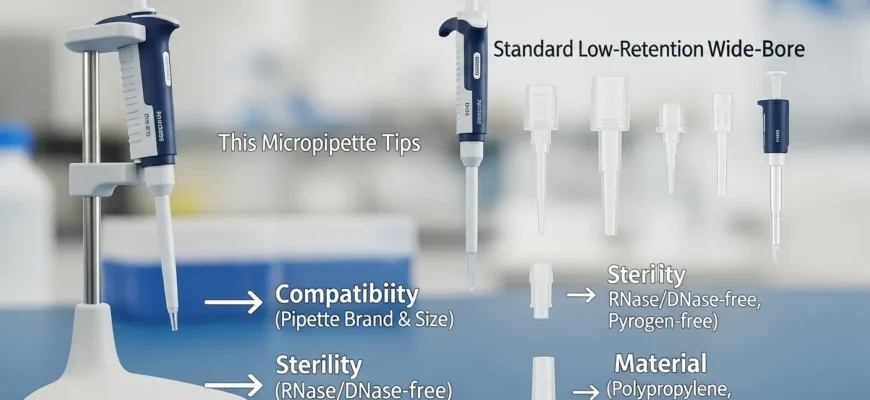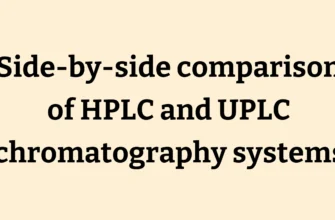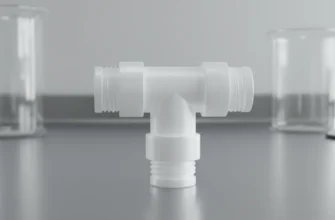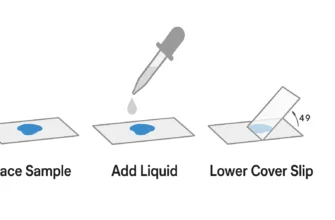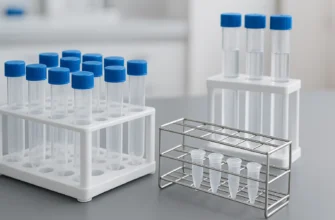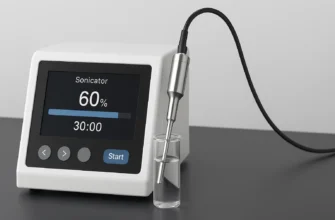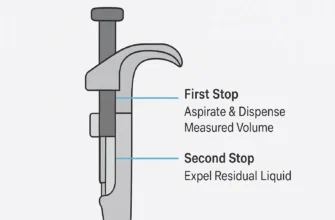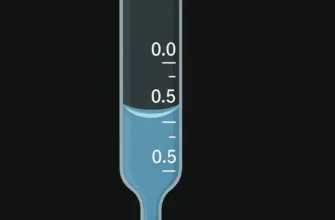A No-Nonsense Guide to Choosing the Right Pipette Tip
The difference between a successful experiment and a frustrating failure often comes down to something as seemingly simple as your pipette tip. Using the wrong tip leads to inaccurate results, sample contamination, or costly reagent loss. While laboratories invest considerable time selecting the perfect pipette, many overlook that the tip is equally critical for reliable, reproducible data. This straightforward guide will ensure you make the right choice every time, saving both time and money while protecting the integrity of your work.
The Non-Negotiable: Pipette and Tip Compatibility
Fit is the first and most critical step in tip selection. A poorly fitting tip compromises the seal between pipette and tip, resulting in inaccuracies, sample loss, or dangerous leakage.
The laboratory world broadly divides into two camps: universal tips versus manufacturer-specific designs. Universal tips are engineered to work across multiple pipette brands, providing flexibility and potentially lower costs. However, manufacturers like Gilson with their Diamond tips and Eppendorf with their epT.I.P.S. system design proprietary tips specifically optimized for their pipettes.
The simplest path to a secure seal: check your pipette manufacturer’s recommendations first. Eppendorf’s epT.I.P.S. system, for example, features ergonomically designed cone geometry that ensures complete sealing with reduced attachment and ejection forces. While universal tips can work well, manufacturers typically recommend using tips of the same brand as the pipette because “the pipette and tip can be considered a system”.
For laboratories using mixed pipette brands, universal tips from reputable manufacturers offer compatibility with popular brands including Eppendorf, Thermo, Gilson, Rainin, and Sartorius. However, always verify compatibility through testing, as a secure visual fit doesn’t guarantee accurate pipetting performance.
Match the Tip to Your Task
Different laboratory applications demand specific tip characteristics. Here’s how to choose the right type for your work:
Standard Tips: Your Everyday Workhorse
Standard pipette tips handle routine, non-critical liquid handling with aqueous solutions. These polypropylene tips work well for general buffer transfers, dilutions, and basic laboratory procedures where contamination isn’t a primary concern. They’re cost-effective and suitable when working with simple solutions like water or standard buffers.
Filter Tips: Essential Contamination Barriers
Filter tips, also called aerosol barrier tips, contain a hydrophobic filter inside the proximal part of the tip. This filter serves dual purposes: protecting your pipette from aerosols and preventing cross-contamination between samples.
Essential applications for filter tips:
-
PCR and molecular biology work
-
Cell culture applications
-
Handling infectious samples
-
Working with volatile, corrosive, or viscous samples
-
RNA/DNA solutions
-
Radio-labeled samples
-
Strong acids or bases
The filter creates a “torturous path” aerosol barrier that prevents contamination without significantly increasing resistance or affecting pipetting accuracy. Filter tips typically come pre-sterilized and certified DNase/RNase-free.
Low-Retention Tips: Maximize Sample Recovery
Low-retention (or low-binding) tips feature specially treated surfaces that minimize liquid adhesion, reducing sample loss by three to five times compared to standard tips. These tips use hydrophobic polypropylene blends or surface treatments to prevent viscous liquids from “wetting” the tip walls.
Ideal applications for low-retention tips:
-
PCR, cloning, and sequencing applications
-
Protein analysis and purification
-
Handling precious samples where every microliter counts
-
Viscous solutions like DNA, RNA, proteins, and enzymes
-
Small volumes under 10 µL
-
Serial dilutions requiring high accuracy
Important consideration: Choose tips with polypropylene blends over silicone coatings, as coatings can wash out and contaminate your samples.
Wide-Bore Tips: Protect Fragile Samples
Wide-bore tips feature orifice openings up to 70% larger than standard tips, reducing mechanical shearing forces that can damage delicate samples. The wider opening prevents cell fragmentation and maintains higher viability rates.
Perfect for:
-
Fragile cell lines and primary cultures
-
Genomic DNA (prevents shearing)
-
Whole blood samples
-
Hepatocytes and hybridomas
-
Other highly viscous materials
-
Any application where sample integrity is critical
Understanding Quality Beyond the Box
Quality in pipette tips means more than just manufacturing consistency—it encompasses sterility, purity, and reliable performance that directly impacts your experimental results.
Sterility: When It Matters Most
Sterile tips undergo rigorous sterilization processes, typically gamma irradiation or electron beam sterilization, achieving sterility assurance levels (SAL) of 10⁻⁶. This means less than one in a million tips could potentially harbor viable microorganisms.
Sterility is crucial for:
-
Cell culture applications
-
Molecular biology work
-
Clinical diagnostics
-
Any work requiring aseptic technique
For routine chemical preparation or non-biological applications, sterility may be unnecessary, allowing cost savings through non-sterile options.
Purity Certifications: The Critical Details
High-quality tips carry multiple purity certifications:
DNase-free: Essential for DNA work, with detection limits typically below 6.25×10⁻⁵ U/μL
RNase-free: Critical for RNA applications, with detection limits below 1×10⁻⁸ U/μL
Endotoxin-free: Important for cell culture, with levels below 0.005 IU/mL
Human DNA-free: Necessary for sensitive molecular work, with detection limits below 1 pg/μL
ATP-free: Required for certain enzymatic assays
Manufacturing Consistency: The Foundation of Reliability
Quality manufacturing ensures tip-to-tip consistency through automated production in cleanroom environments. Look for tips manufactured from virgin polypropylene without additives, as recycled materials or slip agents can introduce variability.
High-quality molding prevents common issues like flashing and burrs that cause retention problems and compromise accuracy. Proper quality control includes testing each batch for dimensional consistency and performance standards.
How to Know Which Pipette Tip to Use?
Start with these three essential questions:
-
What’s my pipette brand and model? Check compatibility charts or manufacturer recommendations first
-
What am I pipetting? Consider liquid properties (viscous, volatile, biological, etc.)
-
What level of protection do I need? Determine if you need sterile, filtered, or specialized tips
Volume considerations matter too: Use tips within the optimal range of your pipette (ideally 35-100% of maximum volume) for best accuracy and precision. For a 100 µL pipette, avoid using it for 10 µL dispenses if accuracy is critical.
How to Read a 10 mL Pipette?
Reading a 10 mL serological pipette requires understanding its dual graduation system:
Two-scale system: Most 10 mL pipettes feature bidirectional graduations—one scale counting down (0-9 mL) and another counting up (1-10 mL).
Reading technique:
-
Hold the pipette vertically or at slight angle
-
Align your eye with the liquid level
-
Read from the bottom of the meniscus where it intersects graduation marks
-
Record measurements to the hundredths place (0.01 mL precision)
Blow-out design: Look for the two rings at the top indicating this is a “blow-out” pipette that must be completely emptied to deliver the stated volume.
How to Choose Pipette Size?
Match the pipette capacity to your application needs:
Micropipettes (0.1 µL to 1000 µL):
-
P2 (0.2-2 µL): DNA amplification, molecular biology
-
P10 (0.5-10 µL): Small reagent transfers
-
P20 (2-20 µL): PCR setup, enzyme additions
-
P200 (20-200 µL): Medium volume transfers
-
P1000 (100-1000 µL): Larger sample handling
Macropipettes (1-10+ mL):
-
1-5 mL: Cell culture media changes
-
5-10 mL: Buffer preparations
-
10+ mL: Large volume transfers
Optimal accuracy occurs when working between 35-100% of the pipette’s maximum volume. Choose a smaller pipette for better precision with small volumes rather than using a large pipette at its minimum range.
What is a 10 mL Pipette Used For?
The 10 mL serological pipette serves as a versatile tool for medium-to-large volume transfers in various laboratory applications:
Cell culture applications:
-
Dispensing culture media
-
Adding buffers and supplements
-
Transferring cell suspensions
Clinical and diagnostic work:
-
Sample preparation
-
Serum and plasma handling
-
Buffer and reagent preparation
General laboratory use:
-
Biochemical assays
-
Solution preparation
-
Microbiology applications
-
Academic research and teaching
Key specifications: Most 10 mL pipettes offer accuracy within ±2% (±200 μL) with graduation marks every 0.1 mL for precise volume control.
Your Quick Selection Checklist
Before selecting your pipette tips, answer these three simple questions:
1. Does it fit my pipette perfectly?
-
Check manufacturer compatibility charts
-
Verify secure seal without wobbling
-
Test with your specific pipette model when possible
2. What am I pipetting?
-
Aqueous solutions: Standard tips usually sufficient
-
Biological samples: Filter tips for contamination protection
-
Viscous/precious samples: Low-retention tips for maximum recovery
-
Fragile cells/DNA: Wide-bore tips to prevent shearing
3. How clean does it need to be?
-
Routine chemistry: Standard non-sterile tips
-
Cell culture/molecular biology: Sterile, DNase/RNase-free tips
-
Sensitive assays: Full purity certification required
Taking a moment to choose correctly saves time, money, and ensures your experimental work stands on a solid foundation. The right tip isn’t just an accessory—it’s an integral part of your measurement system that can make the difference between reliable results and costly mistakes.
Remember: when in doubt, err on the side of higher quality. The cost difference between standard and specialized tips is minimal compared to the value of accurate, reproducible results and the time saved avoiding troubleshooting contamination or accuracy issues.

